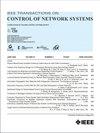Minimal Sensor Placement for Generic State and Unknown Input Observability
IF 4
3区 计算机科学
Q2 AUTOMATION & CONTROL SYSTEMS
引用次数: 0
Abstract
This article addresses the problem of selecting the minimum number of dedicated sensors to achieve observability in the presence of unknown inputs, namely, the state and input observability, for linear time-invariant systems. We assume that the only available information is the zero–nonzero structure of system matrices, and approach this problem within a structured system model. We revisit the concept of state and input observability for structured systems, providing refined necessary and sufficient conditions for placing dedicated sensors via the Dulmage–Mendelsohn decomposition. Based on these conditions, we prove that determining the minimum number of dedicated sensors to achieve generic state and input observability is NP-hard, which contrasts sharply with the polynomial-time complexity of the corresponding problem with known inputs. We also demonstrate that this problem is hard to approximate within a factor of通用状态和未知输入可观测性的最小传感器配置
本文解决了在存在未知输入的情况下选择最小数量的专用传感器以实现可观察性的问题,即线性时不变系统的状态和输入可观察性。我们假设唯一可用的信息是系统矩阵的零-非零结构,并在一个结构化的系统模型中处理这个问题。我们重新审视了结构化系统的状态和输入可观察性的概念,通过Dulmage-Mendelsohn分解为放置专用传感器提供了完善的充分必要条件。基于这些条件,我们证明了确定最小专用传感器数量以实现一般状态和输入可观察性是np困难的,这与已知输入的相应问题的多项式时间复杂度形成鲜明对比。我们还证明了这个问题很难在$(1-o(1))\mathrm{{log}}(n)$的因子范围内进行近似,其中$n$是状态维度。然而,我们提出了可以在多项式时间内计算的非平凡上界和下界,这将问题的最优值限制在一个长度为输入个数的区间内。我们进一步给出了在多项式时间内可以确定精确最优值的一种特殊情况。此外,我们提出了一个两阶段算法来近似地解决这个问题。算法的每个阶段都是最优或次优的,并且可以在多项式时间内完成。
本文章由计算机程序翻译,如有差异,请以英文原文为准。
求助全文
约1分钟内获得全文
求助全文
来源期刊

IEEE Transactions on Control of Network Systems
Mathematics-Control and Optimization
CiteScore
7.80
自引率
7.10%
发文量
169
期刊介绍:
The IEEE Transactions on Control of Network Systems is committed to the timely publication of high-impact papers at the intersection of control systems and network science. In particular, the journal addresses research on the analysis, design and implementation of networked control systems, as well as control over networks. Relevant work includes the full spectrum from basic research on control systems to the design of engineering solutions for automatic control of, and over, networks. The topics covered by this journal include: Coordinated control and estimation over networks, Control and computation over sensor networks, Control under communication constraints, Control and performance analysis issues that arise in the dynamics of networks used in application areas such as communications, computers, transportation, manufacturing, Web ranking and aggregation, social networks, biology, power systems, economics, Synchronization of activities across a controlled network, Stability analysis of controlled networks, Analysis of networks as hybrid dynamical systems.
 求助内容:
求助内容: 应助结果提醒方式:
应助结果提醒方式:


